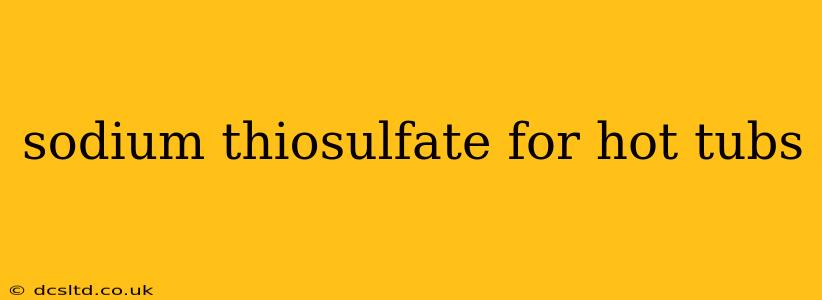Maintaining a sparkling clean and safe hot tub requires diligent attention to water chemistry. While chlorine and bromine are common sanitizers, sodium thiosulfate (STS) plays a crucial role in addressing specific water issues, particularly those related to chlorine or bromine levels. This comprehensive guide explores the uses, benefits, and precautions associated with using sodium thiosulfate in your hot tub.
What is Sodium Thiosulfate?
Sodium thiosulfate is a chemical compound with the formula Na₂S₂O₃. In the context of hot tub maintenance, it's primarily used as a chlorine neutralizer. It effectively removes excess chlorine or bromine, reducing their concentration in the water. This is particularly useful in situations where you've accidentally added too much sanitizer or are dealing with combined chlorine (chloramines), which can cause unpleasant odors and irritation. It's a powerful reducing agent, meaning it donates electrons to other substances, effectively neutralizing the oxidizing power of chlorine.
Why Use Sodium Thiosulfate in a Hot Tub?
There are several key reasons why hot tub owners might utilize sodium thiosulfate:
-
Shock Treatment: While not a shock in the traditional sense (like non-chlorine shock), STS can help quickly neutralize high chlorine levels after an accidental over-addition. This prevents potential damage to your hot tub's equipment and prevents skin and eye irritation.
-
Chloramine Reduction: Combined chlorine, or chloramines, are formed when chlorine reacts with organic contaminants like sweat, body oils, and lotions. These chloramines cause that characteristic "chlorine smell" and can irritate skin and eyes. STS effectively breaks down chloramines, leaving your water cleaner and clearer.
-
Preparation for Metal Removal: Before using a metal sequestrant to remove metals from the water, using STS can help reduce the levels of chlorine present. High chlorine levels can interfere with the effectiveness of some metal removers.
-
Post-Treatment Cleanup: After using a strong oxidizer or other harsh chemicals, STS can help neutralize any residual chemicals, restoring the water’s balance.
How to Use Sodium Thiosulfate in a Hot Tub?
Always follow the manufacturer's instructions on the packaging of your specific sodium thiosulfate product. Generally, the process involves:
-
Test your water: Determine your current chlorine or bromine level using a reliable test kit. This will help you determine the appropriate amount of STS to add.
-
Calculate the dosage: Follow the instructions on the sodium thiosulfate product to determine the correct amount based on your hot tub's water volume and the level of chlorine or bromine you need to neutralize.
-
Add the sodium thiosulfate: Slowly add the calculated amount of STS to the hot tub while the jets are running. This ensures proper distribution throughout the water.
-
Wait: Allow the STS to work for the recommended time (usually 30-60 minutes) before retesting the water.
-
Retest and adjust: After the waiting period, retest your water to check the chlorine or bromine levels. If necessary, repeat the process until the levels are within the desired range.
Important Note: Never mix sodium thiosulfate with other chemicals, especially chlorine-based products. This can create hazardous reactions.
What Happens After Adding Sodium Thiosulfate?
After adding sodium thiosulfate, the chlorine or bromine will be neutralized, converting into harmless substances. This should result in a noticeable reduction in the chlorine smell and potential skin irritation. Your water will likely appear clearer and the overall water quality will improve.
What are the potential side effects of using sodium thiosulfate?
Generally, sodium thiosulfate is considered safe for use in hot tubs at the recommended dosages. However, excessive use can potentially lead to a temporary reduction in sanitizing power. Ensure you always follow the manufacturer's instructions carefully, and retest your water regularly to maintain proper balance.
Can I use sodium thiosulfate if I use a non-chlorine sanitizer?
Sodium thiosulfate's primary function is to neutralize chlorine and bromine. Therefore, it's not necessary or beneficial to use it with non-chlorine sanitizers like mineral systems or ozone.
Is sodium thiosulfate dangerous?
While generally safe when used according to instructions, sodium thiosulfate can cause skin and eye irritation if directly contacted in concentrated form. Always wear appropriate protective gear (gloves and eye protection) when handling it. Keep it out of reach of children and pets.
Conclusion
Sodium thiosulfate is a valuable tool for maintaining healthy and balanced water in your hot tub. By understanding its uses and taking the necessary precautions, you can effectively manage chlorine and bromine levels, eliminate chloramines, and enjoy a cleaner, more comfortable hot tub experience. Remember always to follow the manufacturer's instructions carefully and retest your water regularly to maintain a safe and enjoyable hot tub environment.
